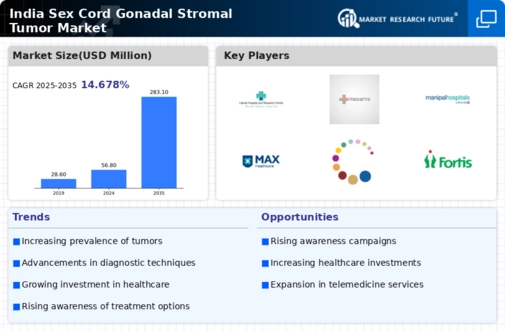Increasing Incidence of Tumors
The rising incidence of sex cord-gonadal-stromal tumors in India appears to be a significant driver for the sex cord-gonadal-stromal-tumor market. Recent studies indicate that these tumors, although rare, are increasingly diagnosed among both genders, particularly in the reproductive age group. The National Cancer Registry Program of India has reported a notable increase in cases, suggesting a potential rise in demand for specialized treatment options. This trend may lead to greater investment in healthcare infrastructure and resources dedicated to oncology, thereby expanding the market. Furthermore, the growing number of healthcare facilities equipped to handle such cases could enhance patient access to necessary treatments, ultimately contributing to market growth.
Rising Health Insurance Coverage
The expansion of health insurance coverage in India is expected to positively influence the sex cord-gonadal-stromal-tumor market. With more individuals gaining access to health insurance, the financial burden of cancer treatment is alleviated, encouraging patients to seek timely medical intervention. As of 2025, it is projected that health insurance penetration in India will reach approximately 50%, which may lead to increased diagnosis and treatment of rare tumors. This trend could result in a higher demand for specialized services and therapies, ultimately driving market growth. Additionally, insurance companies may begin to cover more advanced treatment options, further enhancing patient access.
Enhanced Healthcare Infrastructure
India's ongoing improvements in healthcare infrastructure are likely to bolster the sex cord-gonadal-stromal-tumor market. The government has been investing heavily in healthcare facilities, particularly in rural areas, to ensure better access to medical services. This expansion includes the establishment of specialized cancer treatment centers that focus on rare tumors, including sex cord-gonadal-stromal tumors. As of 2025, the healthcare expenditure in India is projected to reach approximately $300 billion, which may facilitate advancements in diagnostic and therapeutic technologies. Enhanced infrastructure not only improves patient outcomes but also encourages research and development in oncology, thereby positively impacting the market.
Growing Investment in Oncology Research
The increasing investment in oncology research in India is a crucial driver for the sex cord-gonadal-stromal-tumor market. Various public and private entities are channeling funds into research initiatives aimed at understanding rare tumors better. In 2025, it is estimated that research funding for cancer-related studies could exceed $1 billion, with a portion allocated specifically for rare tumor types. This influx of capital may lead to breakthroughs in treatment protocols and personalized medicine, which could significantly enhance patient care. As research progresses, the availability of innovative therapies is likely to attract more patients, thereby expanding the market.
Collaboration Between Public and Private Sectors
The collaboration between public and private sectors in India is emerging as a vital driver for the sex cord-gonadal-stromal-tumor market. Partnerships between government health agencies and private healthcare providers are fostering a more integrated approach to cancer care. These collaborations often lead to the establishment of specialized treatment protocols and shared resources, which can enhance the quality of care for patients with rare tumors. As of November 2025, several initiatives are underway to improve patient outcomes through joint research and clinical trials. This synergy may not only improve treatment efficacy but also stimulate market growth by attracting more stakeholders into the sector.



















Leave a Comment